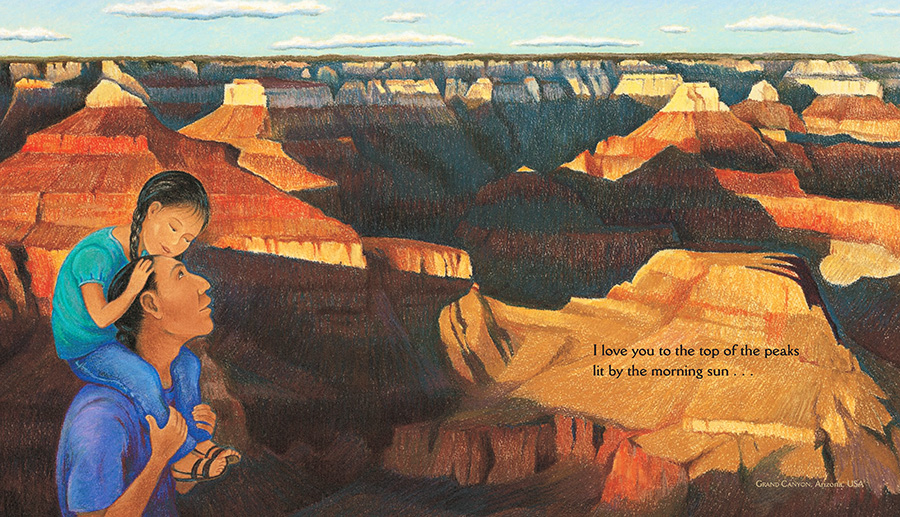
Lulu Delacre is the author and illustrator of many award-winning children’s books, including H![]() ow Far Do You Love Me? and Arrorró, mi niño. In this guest blog post Lulu shares the valuable lessons she’s learned in her journey from illustrator to author.
ow Far Do You Love Me? and Arrorró, mi niño. In this guest blog post Lulu shares the valuable lessons she’s learned in her journey from illustrator to author.
“Me? Write a Story? In a language not my own? I can’t! I graduated from art school!”
That was my reaction to the suggestion of editors and art directors from children’s publishers in New York who saw my sketches back in 1984. From the doodles of my boredom a character had been born, complete with a name and attributes, and I shopped him around in the hopes of illustration assignments.

The scheduled interviews led to a meeting with Barbara Lucas, former assistant editor to the legendary Ursula Nordstrom at Harper & Row. Barbara was the first of several great editors throughout my career who have provided me with enlightening advice. “Your character needs a friend,” Barbara said. At that suggestion my self-imposed handicap began to erode. I thought, what if Nathan is asleep one night and a mouse comes into his room and sets up house in his toy chest? That question, the many sketches that followed, the clumsy first manuscript, and my editor’s guidance, led to the first book I ever wrote and illustrated: Nathan and Nicholas Alexander.
In the process I discovered two things: first, as long as I am creative and willing to learn I can channel my natural creativity into another means of communication, and second, writing in a language not my own requires discipline, humility, and the ability to listen to those who are willing to share an honest opinion so I can improve my skills. Since that first book I’ve authored many more, and all but one are illustrated by me. Along the way I’ve learned some valuable lessons:
Read Good Literature
Early on I spent hours in the children’s section of my public library reading books. Once I transcribed the text of Sendak’s Where the Wild Things Are, to learn the cadence and rhythm of a picture book story I regard as perfect. This exercise allowed me to see that in a great picture book the words, images, and design all work in perfect harmony to transport the reader into the world of the story. Today I’m an avid reader of adult fiction and nonfiction and know that reading improves my writing skills.
Write from the Heart
I create books that speak to me and that I would have wanted to read when young. I create books that I must share with the children in my life and that my inner voice tells me should be on the market.
The Story Comes First Unless the Character Comes First
As an artist this must have been my hardest lesson! If I am writing a story that is not character driven, editing a collection of folklore, or writing for an older audience, I always concentrate on the manuscript first. I revise, edit, revise some more, and only when the manuscript is ready will I don my artist’s hat to determine the perfect art to complement and enrich the story. This is a cardinal rule that I only break when a picture book character is born out of my sketches. Then I’ll draw the character doing all sorts of things until I get to know him or her. Knowing my character enables me to write the character into situations and imagine how he or she would behave.
Read Your Manuscript Aloud
As a native Spanish speaker, I still make a lot of mistakes that I am most likely to catch when I listen to my own words. Silent reading can conceal many grammatical errors!
Ask Writer Friends to Critique Your Work
Since my native tongue is Spanish, there are times when my brain delivers literal translations. The English sentence may be correct, but awkward. This is when my critique group is essential, pointing these out. Then I can choose if I want to leave it as is for the “Latino” flavor or if it’s better to reword the sentence or passage.
Read Your Work to Your Intended Audience
Sharing my work with kids when I go to schools and libraries is invaluable. This is when I learn what does and doesn’t work.
Patience and Persistence
I’ve learned to allow a story to percolate slowly until I know I am ready to write it. Once I have written it I am very persistent and do not get discouraged by rejections of a project in which I truly believe. Twenty-two publishers rejected one of my submissions before it was published and became a commercial success.
When Stuck, Draw
The most important thing is to be creative. So when I run into writer’s block, I draw, paint, or take a walk in the neighborhood. I came up with the poem for my latest book, How Far Do You Love Me?, during a forty-five-minute walk on a cloudless fall day!
Today I can proudly say that I am the illustrator of thirty-four books and the author of seventeen of those. I feel as comfortable illustrating another author’s manuscript as I feel writing my own. I can say this because I listen carefully to my inner voice, my critique group, and my editors. I love a challenge and find there is nothing more challenging than being the author/illustrator of a children’s book!

For more information about Lulu Delacre visit luludelacre.com.

